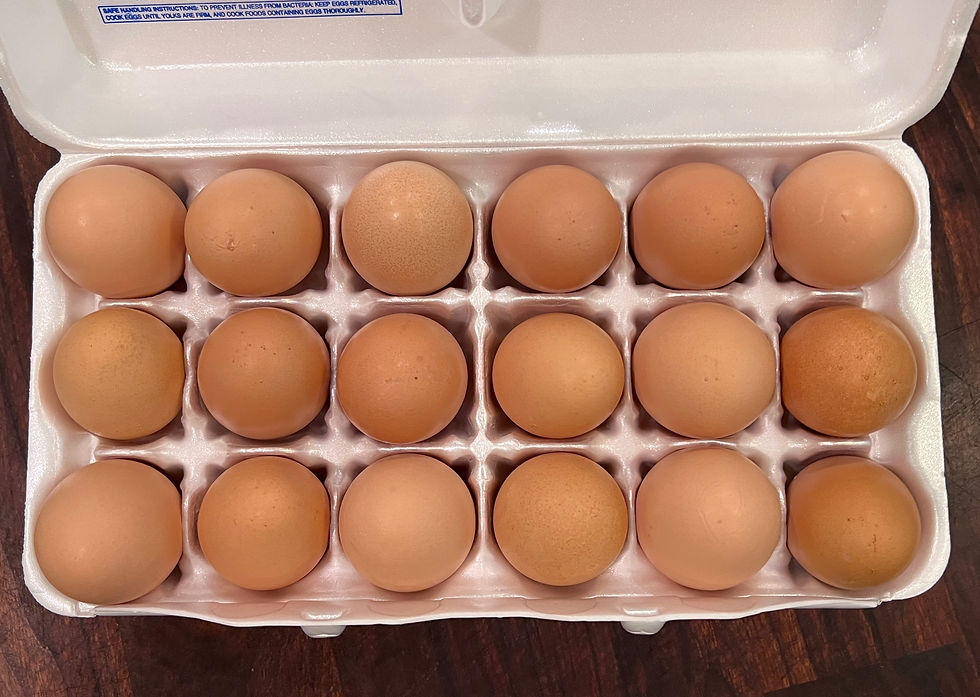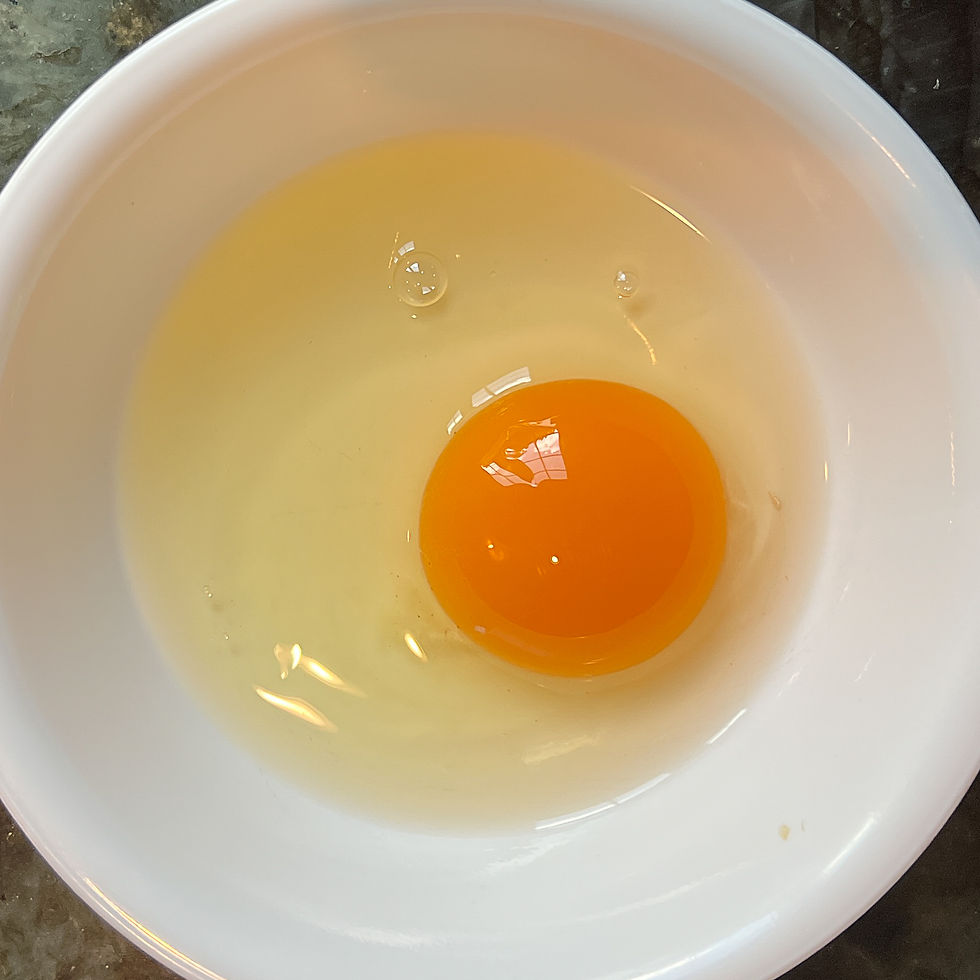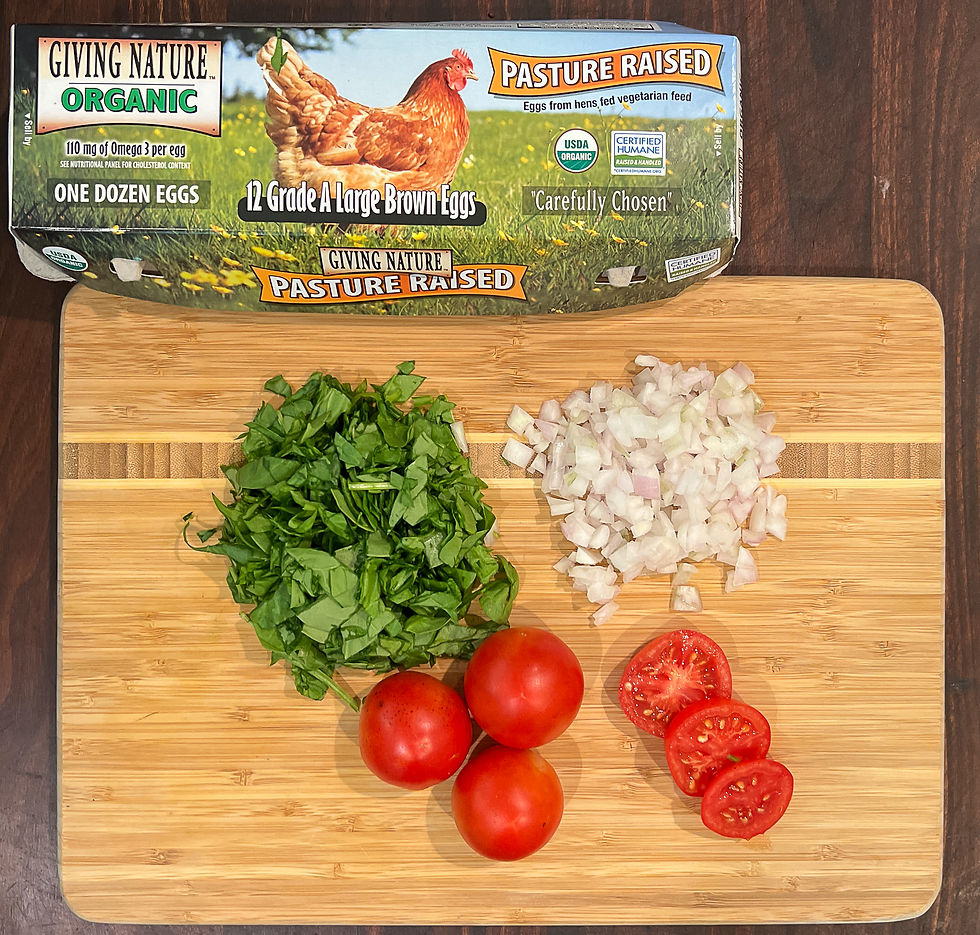Flexible Frittata
- Kristin Stitz

- Aug 22, 2023
- 5 min read
Updated: Aug 23, 2023

If you’re looking for a high-protein, make-ahead breakfast that’s easy to put together – here you go! This simple frittata can be made with any combination of vegetables, meat, and cheese. I used sauteed onions, spinach, tomatoes, and feta for a Greek flair, but you can just as easily make a Western frittata with ham, peppers, and onions, or choose smoked salmon, goat cheese, and asparagus for a Sunday brunch vibe.

I teased this recipe back in May when I posted a picture of 18 eggs that I got from my sister-in-law, who raises chickens in her back yard. I said that I was so excited that eggs were in season!
The Incredible Seasonal Egg
I’ve written a lot this summer about the joys of seasonal fruits and vegetables that are at their peak of flavor and nutrition in the long days of summer. It turns out that the long days are good for chickens too. The more hours of daylight they have, the more often they ovulate, so if chickens are raised outdoors in a natural environment, they will produce the bounty of their eggs in the summer.
This brings up the question, how do eggs show up in the supermarket all year round? The answer – artificial light. If you have ever travelled down Route 1 into southern Delaware, you can see lots of egg production houses - long and low structures where huge numbers of chickens spend their lives producing eggs. Not only do these chickens live under artificial light, but they also eat artificial food, made from soy and corn.
A chicken's natural diet is grubs, insects, worms, seeds, and local plants. Like any good mama, a hen will digest its food and send the best nutrients to her egg. Eggs are designed to provide all the nutrition a growing chick needs.
That's why eggs are so good for us too. Inside the perfect eggshell container is a powerhouse combination of protein, fat (including essential fatty acids), and vitamin like beta-carotene, vitamin A, and vitamin E. Along with fish, eggs are one of the few natural food sources of vitamin D.
Pastured Egg Nutrition

A 2010 study out of Penn State* found that eggs from chickens that were allowed to forage outside contained twice as much Vitamin E, more essential fatty acids with a higher omega-3 to omega-6 ratio, and more Vitamin A than conventionally raised eggs. You can see this nutrition in the color of the yolk. The lovely carrot-y color comes from the beta carotene.
There is no regulation around the term ‘pastured eggs’ but brands such as Vital Farms and Pete and Gerry's tell you about their chicken-raising practices on their websites. They can also be 'certified humane' if certain standards for animal welfare are met. Unfortunately, pastured eggs cost two or three times as much as conventionally raised eggs – and the price of all eggs has risen a lot lately. I'm mindful of asking people to buy expensive products, but I think high-quality eggs is a good place to put your food dollar. Even at their most highly-inflated price, 18 pastured eggs from Vital Farms only costs $9, or 50 cents an egg. If you can get them from a friend who raises eggs and is trying to get rid of their surplus, even better.
I also like eggs because they contain 6 grams of protein each. My frittata recipe bumps up the protein even more with cottage cheese, and meat, if you choose to include it. Not to sound like a broken record, but eating protein is a great way to start your day!
Customized eating plans that work for you is what I do. I would love to talk to you about how we can work together to help you achieve your health goals.
Recipe Variations

To vary this recipe, choose 2 cups of your favorite vegetables, half a cup of cheese, and half a cup of additional protein (optional). Customize the herbs and spices according to your taste.
Make a Chicken Divan inspired frittata with broccoli, mushrooms, Swiss cheese, and last night's left over chicken, or go Italian with zucchini, tomatoes and sausage.
Sturdy vegetables like onions and peppers should be sautéed first as the cooking time isn't long enough for them to soften without precooking. Softer vegetables can be added raw.
Instead of making this in a cast-iron skillet, you can divide the ingredients among 12 muffin cups, layering as below. As an experiment, I made half in regular metal muffin tin greased with oil, and half in a silicone muffin tin. The egg muffins baked in the metal tin stuck, and it was a bear to clean. Definitely not what you want for an easy recipe! They didn't stick to the silicone muffin pan, and cleanup was a breeze.
As much as I would like to be able to freeze this recipe, it doesn't work well with vegetables that have a lot of water in them - like the spinach and tomatoes in the combo below. I froze onion, pepper, and ham egg muffins (above) and they tasted fine when defrosted.
As written below, one slice of the frittata cut into 4 slices contains 19 grams protein. If cut into 6 slices, each has 14 grams. I normally recommend about 30g protein per meal, so I pair mine with 2 slices of turkey bacon for an additional 12 grams.
Tomato, Spinach, and Feta Cheese Frittata
Serves 4-6
Ingredients

8 eggs, preferably pastured
1/2 cup cottage cheese
1/2 teaspoon salt
1/4 teaspoon black pepper
1+ tablespoon olive oil
1/2 cup diced onion
1-1/2 cup baby spinach, coarsely chopped
1 large or 2 medium tomatoes
1/4 teaspoon oregano
Instructions

Preheat oven to 375 degrees
Crack eggs into a blender and add cottage cheese, salt, and pepper. Blend briefly until mixture is smooth. (You can also do this in a bowl with a whisk or fork.)
Heat the olive oil in an 8 or 9 inch cast-iron skillet over medium heat
Saute the diced onions until they are beginning to turn golden.
If necessary, add a bit of olive oil to the pan until it is evenly coated with a thin layer. Pour in the egg and cottage cheese mixture. Let sit for a minute or two until it begins to set around the edges.
With a thin spatula, carefully pull the cooked edge away from the side of the pan, then tilt the pan so that some of the uncooked egg runs to the bottom of the pan. Repeat the motion going around the edges of the pan. The goal is to speed the cooking of the middle of the frittata by exposing more of it to the heat of the bottom of the pan.
Sprinkle the eggs with the chopped spinach, sliced tomatoes, feta cheese and oregano.
Move the pan to the hot oven and bake until the frittata is puffy and browned on top, about 10 minutes. Cool briefly before cutting into 4-6 wedges.
Leftover frittata can be refrigerated and reheated in the oven or microwave for an easy breakfast the rest of the week.
19g protein, 8g carbohydrates, 13g fat



